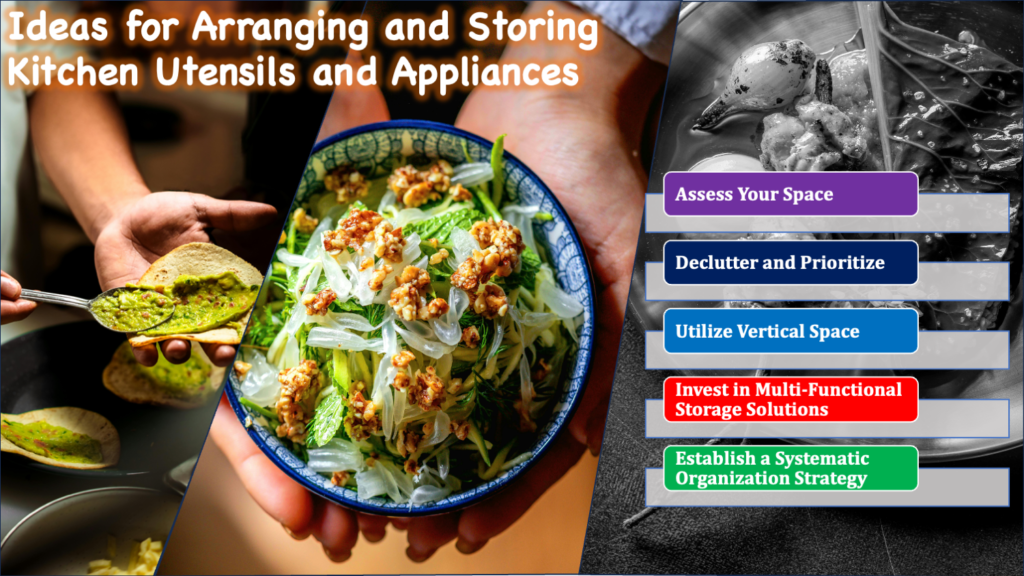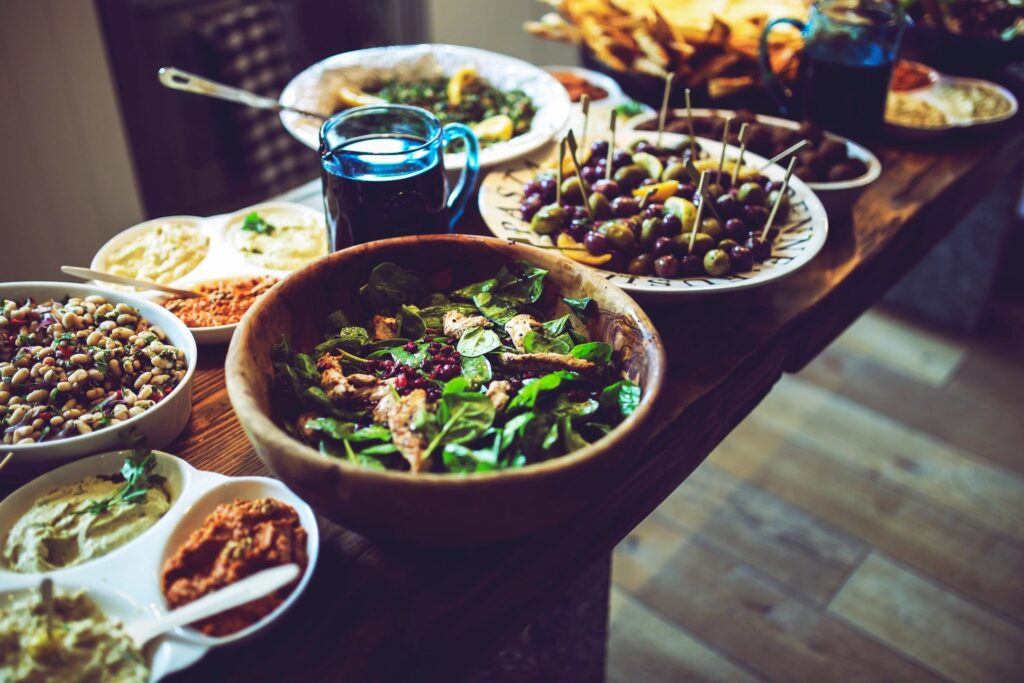To Share is to Show You Care!
Are you tired of rummaging through cluttered drawers and cabinets every time you need a kitchen utensil or appliance? If so, you’re not alone. Many homeowners struggle with the challenge of organizing and storing their culinary tools effectively. Fortunately, there are practical solutions to streamline your kitchen space and make cooking a breeze.
Here are some expert tips and tricks to conquer the chaos and optimize your kitchen organization:

1) Assess Your Space
- Take stock of your kitchen layout and available storage areas.
- Identify unused or underutilized spaces that can be repurposed for storage.
- Consider investing in storage solutions tailored to your kitchen’s dimensions, such as drawer organizers, cabinet racks, and wall-mounted shelves
2) Declutter and Prioritize
- Sort through your utensils and appliances and declutter any duplicates, broken items, or gadgets you rarely use.
- Prioritize essential tools and appliances based on frequency of use and accessibility.
- Consider donating or selling items you no longer need to free up space and simplify your kitchen inventory.
3) Utilize Vertical Space
- Make use of vertical wall space by installing hooks, pegboards, or magnetic strips to hang utensils, pots, and pans.
- Hang frequently used items within easy reach for quick access during meal preparation.
- Maximize cabinet space by installing adjustable shelving or stacking organizers to accommodate different-sized appliances and cookware.
4) Invest in Multi-Functional Storage Solutions
- Opt for versatile storage containers, such as stackable bins or baskets, to corral smaller items like measuring spoons, spatulas, and kitchen gadgets.
- Choose storage solutions with modular components or customizable configurations to adapt to your evolving needs over time.
- Explore innovative storage options like drawer dividers, lazy Susans, and pull-out shelves to maximize space efficiency and minimize clutter.
5) Establish a Systematic Organization Strategy
- Group similar items together by category or function to facilitate easier retrieval and maintain order.
- Label storage containers or shelves to clearly identify contents and streamline the organization process.
- Implement a regular maintenance routine to declutter and reorganize as needed, ensuring that your kitchen remains functional and efficient.
Conclusion
By implementing these practical solutions and adopting an organized approach to storing your kitchen utensils and appliances, you can transform your culinary space into a streamlined and efficient environment. Say goodbye to kitchen clutter and hello to hassle-free meal preparation with these expert tips and tricks. Get started today and unlock the full potential of your kitchen!
Frequently Asked Questions
Q1: How to properly store kitchen utensils?
A: Properly storing kitchen utensils involves:
- Sorting utensils by category or function.
- Utilizing drawer organizers or utensil holders to keep items neatly separated and easily accessible.
- Hanging frequently used utensils on hooks or racks for convenience.
- Storing sharp utensils safely to prevent accidents.
Q2: How to organize kitchen appliances?
A: Organizing kitchen appliances can be done by:
- Grouping appliances based on usage frequency.
- Allocating dedicated cabinet or countertop space for each appliance.
- Using appliance garages or pull-out shelves to conceal bulky items when not in use.
- Arranging appliances according to workflow, placing commonly used items within arm’s reach of food preparation areas.
Q3: Which is an approved method for storing and using utensils?
A: An approved method for storing and using utensils is to:
- Clean utensils thoroughly before and after each use to prevent contamination.
- Store utensils in designated areas away from raw food to avoid cross-contamination.
- Use separate utensils for handling raw and cooked foods to prevent foodborne illness.
Q4: What is the most efficient way to organize a kitchen?
A: The most efficient way to organize a kitchen involves:
- Decluttering and prioritizing essential items.
- Maximizing vertical and horizontal storage space.
- Establishing a systematic organization strategy based on usage frequency and workflow.
- Regularly maintaining and reorganizing as needed to keep the kitchen functional and clutter-free.
Q5: How to declutter kitchen utensils?
A: To declutter kitchen utensils, follow these steps:
- Sort through utensils and discard duplicates or items that are no longer in good condition.
- Donate or sell utensils that are seldom used or unnecessary.
- Prioritize essential utensils and arrange them systematically for easy access.
- Implement storage solutions, such as drawer dividers or hanging racks, to keep utensils organized and clutter-free.
Q6: How should you arrange your utensils?
A: Arrange utensils by:
- Sorting similar items together, such as spoons, spatulas, and ladles.
- Allocating designated storage areas for different categories of utensils.
- Utilizing drawer organizers or dividers to keep utensils neatly separated and easily accessible.
- Hanging frequently used utensils on hooks or racks for convenience.
Q7: How do I layout my kitchen storage?
A: Layout your kitchen storage by:
- Assessing available space and identifying storage needs.
- Allocating specific areas for different categories of items, such as utensils, cookware, and pantry staples.
- Utilizing a combination of cabinets, drawers, shelves, and pantry organizers to maximize storage efficiency.
- Implementing storage solutions tailored to your kitchen layout and workflow.
Q8: How should kitchen appliances be arranged?
A: Arrange kitchen appliances by:
- Grouping similar appliances together based on usage frequency and function.
- Allocating dedicated storage space for each appliance to prevent clutter.
- Considering workflow and accessibility when positioning appliances on countertops or in cabinets.
- Using appliance garages or pull-out shelves to conceal bulky items when not in use.
Q9: How do I organize my kitchen accessories?
A: Organize kitchen accessories by:
- Sorting accessories by category, such as cutting boards, measuring cups, and mixing bowls.
- Storing accessories in designated areas, such as drawers, shelves, or countertop organizers.
- Decluttering regularly by removing unused or redundant accessories.
- Utilizing storage solutions, such as stackable bins or baskets, to keep accessories neatly organized and easily accessible.
Q10: What are the 3 guidelines to follow when storing utensils and equipment?
A: The three guidelines to follow when storing utensils and equipment are:
- Clean utensils and equipment thoroughly before and after each use.
- Store utensils and equipment in designated areas away from contaminants.
- Use separate utensils and equipment for handling raw and cooked foods to prevent cross-contamination.
Q11: How to store kitchen utensils without drawers?
A: To store kitchen utensils without drawers:
- Utilize wall-mounted racks or hooks to hang utensils.
- Invest in countertop utensil holders or caddies for easy access.
- Install shelves or open storage units to display and organize utensils.
- Consider utilizing under-cabinet or ceiling-mounted storage solutions for additional space.
Q12: What is the proper handling of utensils?
A: The proper handling of utensils involves:
- Cleaning utensils thoroughly with hot, soapy water before and after each use.
- Avoiding cross-contamination by using separate utensils for handling raw and cooked foods.
- Storing utensils in designated areas away from contaminants and food preparation areas.
- Regularly inspecting utensils for signs of wear or damage and replacing as needed to maintain food safety standards.
Q13: How do I decide where to put things in my kitchen?
A: To decide where to put things in your kitchen, consider:
- Your kitchen layout and available storage space.
- The frequency of use for each item.
- Accessibility and convenience in relation to food preparation areas.
- Establishing zones for different categories of items, such as cooking utensils, pantry staples, and cleaning supplies.
Q14: How to organize a cluttered kitchen?
A: To organize a cluttered kitchen:
- Start by decluttering and removing items that are no longer needed or used.
- Sort through remaining items and group similar items together.
- Utilize storage solutions, such as baskets, bins, and organizers, to corral loose items and keep surfaces clear.
- Establish a systematic organization strategy and maintain regular upkeep to prevent clutter from accumulating.
Q15: What is the simplest and most economical kitchen layout arrangement?
A: The simplest and most economical kitchen layout arrangement is typically the galley kitchen layout, which features parallel countertops and work areas along a single wall or between two parallel walls. This layout maximizes efficiency and workflow in smaller kitchen spaces while minimizing construction and design costs.
The Informed Minds
I'm Vijay Kumar, a consultant with 20+ years of experience specializing in Home, Lifestyle, and Technology. From DIY and Home Improvement to Interior Design and Personal Finance, I've worked with diverse clients, offering tailored solutions to their needs. Through this blog, I share my expertise, providing valuable insights and practical advice for free. Together, let's make our homes better and embrace the latest in lifestyle and technology for a brighter future.

